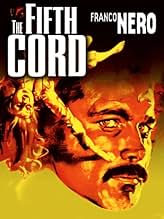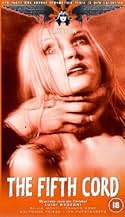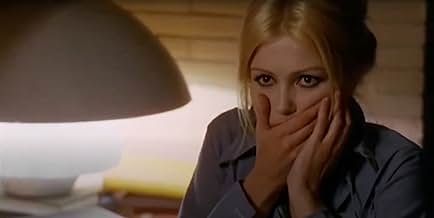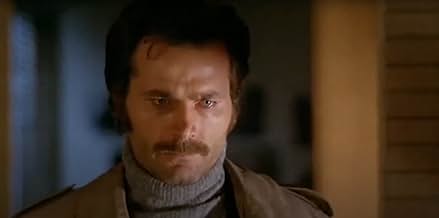VALUTAZIONE IMDb
6,6/10
2807
LA TUA VALUTAZIONE
Un giornalista si trova sulle tracce di un assassino che ha preso di mira le persone intorno a lui, mentre la polizia lo considera un sospetto nelle loro indagini.Un giornalista si trova sulle tracce di un assassino che ha preso di mira le persone intorno a lui, mentre la polizia lo considera un sospetto nelle loro indagini.Un giornalista si trova sulle tracce di un assassino che ha preso di mira le persone intorno a lui, mentre la polizia lo considera un sospetto nelle loro indagini.
- Regia
- Sceneggiatura
- Star
Ira von Fürstenberg
- Isabel Lancia
- (as Ira Fürstenberg)
Luciano Bartoli
- Walter Auer
- (as Luciano Baroli)
Luigi Antonio Guerra
- Man
- (as Guerra L. Antonio)
Michel Barnes
- Tony Volta
- (non citato nei titoli originali)
Jean-Pierre Clarain
- Journalist in Bini's Home
- (non citato nei titoli originali)
- …
Recensione in evidenza
"I am going to commit murder," whispers our killer, as the camera flits around the jaded revellers at a New Year shindig. "I can imagine the thrill and pleasure I will experience as I stalk my victim..." Shortly after, John Lubbock (Maurizio Bonuglia) survives an attack in an underpass on his way home, and journalist Andrea Bild (Franco Nero), a fellow attendee, decides to investigate. Then a second party goer - invalid Doctor's wife Sophia Bini (Rossella Falk) - is attacked and killed in her home, and Andrea's elderly editor is found dead in a local park, both bodies accompanied by the killer's calling card (a black glove with first one then subsequent fingers cut off). Suddenly, the outspoken, hard-drinking journalist finds himself rising swiftly up the list of suspects.
What raises The Fifth Cord above the average giallo is striking cinematography and a couple of genuinely suspense-filled murders. The sequence involving the Doctor's wife is the most characteristic of the genre. Taking place in a huge and intimidating bedroom it also evokes the Gothic feel of old Hollywood and the memory of a certain Mrs de Winter. Bazzoni expertly handles the build-up of tension, getting the unfortunate Mrs Bini out of bed and crawling along the floor in a rising panic as first her wheelchair then telephone (her lifeline) vanish into the shadows. There's an almost supernatural element at play here. When the familiar gloved hands suddenly appear either side of the screen to slowly descend from behind and wrap themselves around her throat, they seem almost disembodied.
In contrast, the rest of the film is a study in modernity. Everything is concrete and glass, clean lines and polished surfaces. Every shot is carefully and deliberately lensed and filled with geometric shapes and patterns. Edges and shadows converge to corral Nero as the finger points increasingly in his direction. A scene in which he meets with the investigating officer in a subterranean parking lot is particularly well done, where the frosted windows behind the actors are reflected in the roof of the car in front and join with the widescreen framing to form a cage. The ending comprises tough-guy fisticuffs and a pulse-quickening chase sequence through the cadaverous wreck of an abandoned factory where Nero finally unmasks the black-coated killer, having already deduced the real motive, which twists the opening voice-over in a new and ambiguous light.
This is a solid, visually impressive giallo, if at times a little less engaging than it should be. The characters, other than Andrea, aren't effectively introduced or given enough screen time and are too often simply referred to by name, so it's difficult to remember who's who and why we should care. Consequently the narrative sometimes lacks clarity, getting itself into a bit of a muddle during the mid-section, and having spent most of the film presuming events have unfolded over a matter of days only to discover the killings have been occurring for roughly a five month period is a little jarring. There's nothing to suggest the passage of time, though the static environment does correspond with Bazzoni's austere vision.
A cold and relatively bleak film, The Fifth Cord makes the most of its angular urban settings to say something about the fractured nature of modern city life, from Nero's world-weary alcoholic loner to the estranged Doctor and his wife to hardworking single parent Helene (Silvia Monti). A world filled with acquaintances as opposed to friends, where people choose the warm bodies of strangers (filmed here with restraint rather than a gratuitous eye for sleaze) over the ones they may have at home. Nero, though at times out-and-out brutish, brings gravitas (and a suitably chiseled visage) to his genre-standard character, and Monti, in a limited role, manages to be strong and insightful and can keep her head in a crisis, helping to counterbalance the popular view of women in gialli as merely window dressing or cannon fodder. The English dubbing is of a high standard, with Nero providing his own voice. Overall it's more of a straightforward crime caper than a horror yarn, but worth checking out for the arresting visuals alone.
What raises The Fifth Cord above the average giallo is striking cinematography and a couple of genuinely suspense-filled murders. The sequence involving the Doctor's wife is the most characteristic of the genre. Taking place in a huge and intimidating bedroom it also evokes the Gothic feel of old Hollywood and the memory of a certain Mrs de Winter. Bazzoni expertly handles the build-up of tension, getting the unfortunate Mrs Bini out of bed and crawling along the floor in a rising panic as first her wheelchair then telephone (her lifeline) vanish into the shadows. There's an almost supernatural element at play here. When the familiar gloved hands suddenly appear either side of the screen to slowly descend from behind and wrap themselves around her throat, they seem almost disembodied.
In contrast, the rest of the film is a study in modernity. Everything is concrete and glass, clean lines and polished surfaces. Every shot is carefully and deliberately lensed and filled with geometric shapes and patterns. Edges and shadows converge to corral Nero as the finger points increasingly in his direction. A scene in which he meets with the investigating officer in a subterranean parking lot is particularly well done, where the frosted windows behind the actors are reflected in the roof of the car in front and join with the widescreen framing to form a cage. The ending comprises tough-guy fisticuffs and a pulse-quickening chase sequence through the cadaverous wreck of an abandoned factory where Nero finally unmasks the black-coated killer, having already deduced the real motive, which twists the opening voice-over in a new and ambiguous light.
This is a solid, visually impressive giallo, if at times a little less engaging than it should be. The characters, other than Andrea, aren't effectively introduced or given enough screen time and are too often simply referred to by name, so it's difficult to remember who's who and why we should care. Consequently the narrative sometimes lacks clarity, getting itself into a bit of a muddle during the mid-section, and having spent most of the film presuming events have unfolded over a matter of days only to discover the killings have been occurring for roughly a five month period is a little jarring. There's nothing to suggest the passage of time, though the static environment does correspond with Bazzoni's austere vision.
A cold and relatively bleak film, The Fifth Cord makes the most of its angular urban settings to say something about the fractured nature of modern city life, from Nero's world-weary alcoholic loner to the estranged Doctor and his wife to hardworking single parent Helene (Silvia Monti). A world filled with acquaintances as opposed to friends, where people choose the warm bodies of strangers (filmed here with restraint rather than a gratuitous eye for sleaze) over the ones they may have at home. Nero, though at times out-and-out brutish, brings gravitas (and a suitably chiseled visage) to his genre-standard character, and Monti, in a limited role, manages to be strong and insightful and can keep her head in a crisis, helping to counterbalance the popular view of women in gialli as merely window dressing or cannon fodder. The English dubbing is of a high standard, with Nero providing his own voice. Overall it's more of a straightforward crime caper than a horror yarn, but worth checking out for the arresting visuals alone.
- SJSondergaard
- 27 mar 2008
- Permalink
Trama
Lo sapevi?
- QuizIsabelle Lancia smokes Astor brand cigarettes, a common favorite of leading ladies in gialli.
- BlooperWhen Andrea enters a car after seeing a woman dead in the bathtub, a cut can clearly be seen when he grabs the wheel.
- Citazioni
Andrea Bild: I may have become a piece of shit but you are what you are when you started, a bastard who sold his soul.
- Versioni alternativeAlthough intact on the cinema a 2 sec cut was made to the UK Redemption video release to edit a throat-cutting.
- ConnessioniFeatured in Giornata nera (2006)
- Colonne sonorePop! Goes the Weasel
(uncredited)
Traditional
I più visti
Accedi per valutare e creare un elenco di titoli salvati per ottenere consigli personalizzati
- How long is The Fifth Cord?Powered by Alexa
Dettagli
- Data di uscita
- Paese di origine
- Lingua
- Celebre anche come
- The Fifth Cord
- Luoghi delle riprese
- Incir De Paolis Studios, Roma, Lazio, Italia(as Incir De Paolis Studios)
- Aziende produttrici
- Vedi altri crediti dell’azienda su IMDbPro
- Tempo di esecuzione1 ora 30 minuti
- Mix di suoni
- Proporzioni
- 1.85 : 1
Contribuisci a questa pagina
Suggerisci una modifica o aggiungi i contenuti mancanti

Divario superiore
By what name was Giornata nera per l'ariete (1971) officially released in India in English?
Rispondi





























